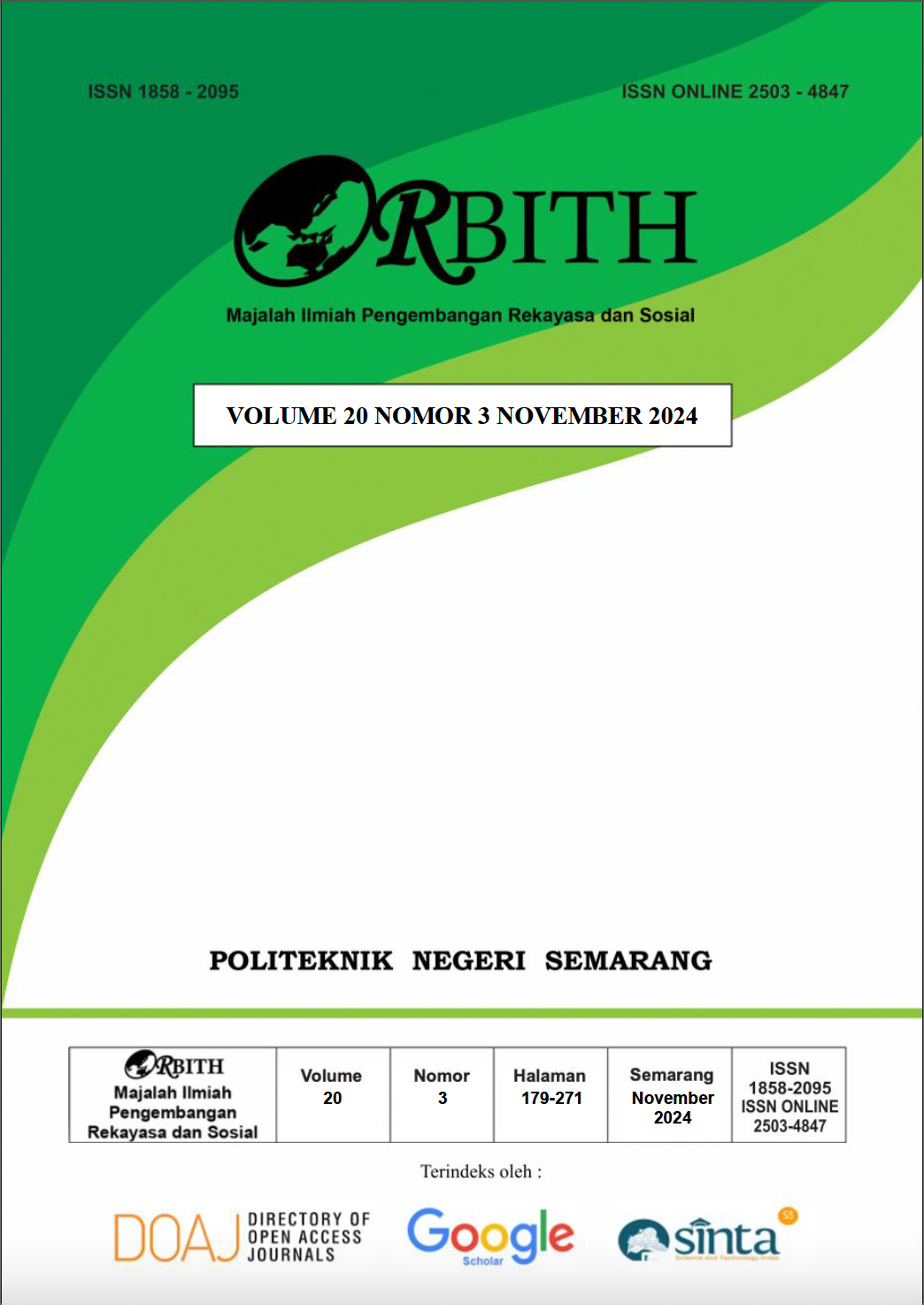EVALUASI KEKUATAN BETON MUTU TINGGI DENGAN MENGGUNAKAN KOMBINASI FLY ASH DAN SILICA FUME SEBAGAI SUBTITUSI SEMEN
DOI:
https://doi.org/10.32497/orbith.v20i3.6257Keywords:
High-Strength Concrete, Fly Ash, Silica Fume, Cement SubstitutionAbstract
Abstrak Beton mutu tinggi merupakan material penting dalam konstruksi modern karena kekuatannya yang unggul dan daya tahannya yang tinggi. Salah satu cara untuk meningkatkan performa beton adalah dengan menggunakan bahan substitusi seperti fly ash dan silica fume sebagai pengganti sebagian semen. Fly ash dan silica fume , yang merupakan produk sampingan industri, telah terbukti meningkatkan kekuatan tekan, daya tahan, dan sifat-sifat mekanis beton. Penelitian ini bertujuan untuk mengevaluasi kekuatan beton mutu tinggi dengan kombinasi fly ash dan silica fume sebagai substitusi semen dalam persentase yang berbeda-beda dengan variasi 1 dengan Fly Ash 5% dan Sicafume 2%, variasi 2 dengan Fly Ash 15% dan Sicafume 6%, variasi 3 dengan Fly Ash 20% dan Sicafume 8%. Hasil penelitian menunjukkan bahwa kuat tekan umur 28 hari menunjukkan variasi 3 mencapai kuat tekan tertinggi 67,93 MPa atau meningkat 60% dari rancangan awal (42 MPa) , diikuti oleh Variasi 2 sebesar 63,03 MPa meningkat 40,1% dan Variasi 1 sebesar 45,85 MPa meningkat 8,6%. Hasil ini memberikan wawasan penting untuk pengembangan beton mutu tinggi yang lebih ramah lingkungan dan efisien dalam biaya konstruksi. Penelitian ini diakhiri dengan kesimpulan bahwa kombinasi fly ash dan silica fume merupakan pilihan yang optimal untuk meningkatkan kekuatan dan daya tahan beton, dengan saran untuk implementasi lebih luas dalam proyek infrastruktur. Kata kunci: Beton Mutu Tinggi, Fly Ash, Silica Fume, Substitusi Semen. Abstract High-strength concrete is a critical material in modern construction due to its superior strength and durability. One method to enhance concrete performance is by using supplementary materials such as fly ash and silica fume as partial replacements for cement. Fly ash and silica fume, which are industrial by-products, have been proven to improve the compressive strength, durability, and mechanical properties of concrete. This study aims to evaluate the strength of high-strength concrete with a combination of fly ash and silica fume as cement substitutes in varying percentages: Variation 1 with 5% fly ash and 2% silica fume, Variation 2 with 15% fly ash and 6% silica fume, and Variation 3 with 20% fly ash and 8% silica fume. The results show that the 28-day compressive strength of Variation 3 achieved the highest strength at 67.93 MPa, representing a 60% increase from the initial design (42 MPa), followed by Variation 2 at 63.03 MPa (a 40.1% increase), and Variation 1 at 45.85 MPa (an 8.6% increase). These findings provide valuable insights for the development of more environmentally friendly and cost-efficient high-strength concrete. The study concludes that the combination of fly ash and silica fume is an optimal choice for improving concrete strength and durability, with recommendations for broader implementation in infrastructure projects. Keywords: High-Strength Concrete, Fly Ash, Silica Fume, Cement SubstitutionReferences
Ahmad, W., Ahmad, A., Ostrowski, K. A., Aslam, F., Joyklad, P., & Zajdel, P. (2021). Application of advanced machine learning approaches to predict the compressive strength of concrete containing supplementary cementitious materials. Materials, 14(19). https://doi.org/10.3390/ma14195762
Ahmad, W., Farooq, S. H., Usman, M., Khan, M., Ahmad, A., Aslam, F., Alyousef, R., Abduljabbar, H. Al, & Sufian, M. (2020). Effect of coconut fiber length and content on properties of high strength concrete. Materials, 13(5). https://doi.org/10.3390/ma13051075
Ali, B., Kurda, R., Herki, B., Alyousef, R., Mustafa, R., Mohammed, A., Raza, A., Ahmed, H., & Ul-Haq, M. F. (2020). Effect of varying steel fiber content on strength and permeability characteristics of high strength concrete with micro silica. Materials, 13(24), 1”“17. https://doi.org/10.3390/ma13245739
Althoey, F., Hakeem, I. Y., Hosen, M. A., Qaidi, S., Isleem, H. F., Hadidi, H., Shahapurkar, K., Ahmad, J., & Ali, E. (2022). Behavior of Concrete Reinforced with Date Palm Fibers. Materials, 15(22). https://doi.org/10.3390/ma15227923
Björklund, H., Björklund, J., & Martens, W. (2021). Learning algorithms. 375”“409. https://doi.org/10.4171/automata-1/11
Farooq, F., Czarnecki, S., Niewiadomski, P., Aslam, F., Alabduljabbar, H., Ostrowski, K. A., Åšliwa-Wieczorek, K., Nowobilski, T., & Malazdrewicz, S. (2021). A comparative study for the prediction of the compressive strength of self-compacting concrete modified with fly ash. Materials, 14(17). https://doi.org/10.3390/ma14174934
Fernando, R., Abda, J., & Taurano, G. A. (2022). Studi Perbandingan Mutu Beton Self Compacting Concrete Terhadap Variasi Penggunaan Air Payau Dengan Menggunakan High ”¦. Orbith: Majalah Ilmiah ”¦, 18(2), 82”“90. https://jurnal.polines.ac.id/index.php/orbith/article/view/3803%0Ahttps://jurnal.polines.ac.id/index.php/orbith/article/download/3803/108158
Fernando, R., Utama, A. B., & Friatmojo, E. K. (2022). Studi Perbandingan Mutu Beton Normal Berdasarkan Variasi Pengambilan Agregat Kasar Di Provinsi Jawa Tengah. Orbith, 18(1), 28”“36.
Golewski, G. L. (2021). Green concrete based on quaternary binders with significant reduced of co2 emissions. Energies, 14(15). https://doi.org/10.3390/en14154558
Huang, H., Yuan, Y., Zhang, W., & Zhu, L. (2021). Property Assessment of High-Performance Concrete Containing Three Types of Fibers. International Journal of Concrete Structures and Materials, 15(1). https://doi.org/10.1186/s40069-021-00476-7
MaÅ‚ek, M., Jackowski, M., Åasica, W., & Kadela, M. (2020). Characteristics of recycled polypropylene fibers as an addition to concrete fabrication based on portland cement. Materials, 13(8). https://doi.org/10.3390/MA13081827
Mostafa, S. A., Faried, A. S., Farghali, A. A., El-Deeb, M. M., Tawfik, T. A., Majer, S., & Elrahman, M. A. (2020). Influence of nanoparticles from waste materials on mechanical properties, durability and microstructure of uhpc. Materials, 13(20), 1”“22. https://doi.org/10.3390/ma13204530
Sagar, B., & Sivakumar, M. V. N. (2020). An Experimental and Analytical Study on Alccofine Based High Strength Concrete. International Journal of Engineering, Transactions A: Basics, 33(4), 530”“538. https://doi.org/10.5829/IJE.2020.33.04A.03
Siddika, A., Amin, M. R., Rayhan, M. A., Islam, M. S., Mamun, M. A. Al, Alyousef, R., & Mugahed Amran, Y. H. (2021). Performance of sustainable green concrete incorporated with fly ash, rice husk ash, and stone dust. Acta Polytechnica, 61(1), 279”“291. https://doi.org/10.14311/AP.2021.61.0279
Sim, J., Kang, Y., Kim, B. J., Park, Y. H., & Lee, Y. C. (2020). Preparation_of_Fly_Ash_Epoxy_Composites_and_Its_Effects_on_Mechanical.Pdf. 1”“12.
Tawfik, M., El-Said, A., Deifalla, A., & Awad, A. (2022). Mechanical Properties of Hybrid Steel-Polypropylene Fiber Reinforced High Strength Concrete Exposed to Various Temperatures. Fibers, 10(6). https://doi.org/10.3390/fib10060053
Ullah, R., Qiang, Y., Ahmad, J., Vatin, N. I., & El-shorbagy, M. A. (2022). Ultra-High-Performance Concrete ( UHPC ): 1”“27.
Xu, Y., Ahmad, W., Ahmad, A., Ostrowski, K. A., Dudek, M., Aslam, F., & Joyklad, P. (2021). Computation of high-performance concrete compressive strength using standalone and ensembled machine learning techniques. Materials, 14(22). https://doi.org/10.3390/ma14227034
Zhao, J., Wang, K., Wang, S., Wang, Z., Yang, Z., Shumuye, E. D., & Gong, X. (2021). Effect of elevated temperature on mechanical properties of high-volume fly ash-based geopolymer concrete, mortar and paste cured at room temperature. Polymers, 13(9). https://doi.org/10.3390/polym13091473
Downloads
Published
Issue
Section
License
Authors who publish with this journal agree to the following terms:Authors retain copyright and grant the journal right of first publication with the work simultaneously licensed under a Creative Commons Attribution License that allows others to share the work with an acknowledgement of the work's authorship and initial publication in this journal.
Authors are able to enter into separate, additional contractual arrangements for the non-exclusive distribution of the journal's published version of the work (e.g., post it to an institutional repository or publish it in a book), with an acknowledgement of its initial publication in this journal.
Authors are permitted and encouraged to post their work online (e.g., in institutional repositories or on their website) prior to and during the submission process, as it can lead to productive exchanges, as well as earlier and greater citation of published work (See The Effect of Open Access).






